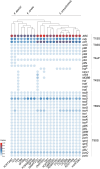Comparative genomic analysis of Flavobacterium species causing columnaris disease of freshwater fish in Thailand: insights into virulence and resistance mechanisms
- PMID: 40389923
- PMCID: PMC12087154
- DOI: 10.1186/s12917-025-04488-3
Comparative genomic analysis of Flavobacterium species causing columnaris disease of freshwater fish in Thailand: insights into virulence and resistance mechanisms
Abstract
Background: Columnaris disease, a prevalent disease among farmed and wild freshwater fish, is caused by the Flavobacterium columnare group, which includes four distinct species: F. columnare, F. oreochromis, F. covae, and F. davisii. Among these, F. oreochromis, F. covae, and F. davisii are particularly prevalent in farmed freshwater fish in Thailand. In this study, a comparative genomic analysis of 22 isolates was conducted to elucidate virulence factors, antibiotic resistance genes (ARGs), genomic islands (GIs), phages, insertion elements (ISs), and clustered regularly interspaced short palindromic repeats (CRISPRs).
Results: A total of 212 putative virulence genes were predicted across three species with F. oreochromis exhibiting the highest number of unique virulence genes, followed by F. davisii, and F. covae. Moreover, 195 genes were predicted as ARGs, with F. oreochromis and F. covae showing an abundance of unique genes associated with resistance to quinolone, fluoroquinolone, and tetracycline antibiotics. Antimicrobial susceptibility testing, assessed with epidemiological cut-off values (ECVs), revealed decreased susceptibility to quinolones, fluoroquinolones and tetracycline in several isolates of F. oreochromis and F. covae. F. oreochromis and F. covae exhibited notable decreased susceptibility to quinolones, with mutations observed in the quinolone resistance-determining regions (QRDRs) of gyrA, including Ser83Phe, Ser83Val, Ser83Ala, and Asp87Tyr, the latter representing a novel mutation among isolates from Thailand. As a result, these findings suggest that gyrA is major target for quinolone in F. oreochromis, F. covae, and F. davisii, while gyrB, parC, parE might be less important to the decreased phenotypic susceptibility to this class of antimicrobials. Moreover, a tetracycline resistance gene (tetA_2) was found in only one F. covae isolate, which exhibited decreased phenotypic susceptibility to this drug, marking the first report of decreased susceptibility in this species.
Conclusions: This study provides insights into the genetic and pathogenic diversity of Flavobacterium species, aiding in the development of strategies to manage columnaris disease in farmed freshwater fish in Thailand.
Keywords: Flavobacterium; Antibiotic resistance; Comparative genome analysis; Freshwater fish; Virulence factor.
© 2025. The Author(s).
Conflict of interest statement
Declarations. Ethics approval and consent to participate: All bacteria isolation and biosafety protocols were reviewed and authorized by the Institutional Biosafety Committee (IBC) at Chulalongkorn University (Approval no. IBC2331024), adhering to the regulations and policies governing biosafety established by the faculty. All animal handling and experimental protocols were conducted with approval from the Institutional Animal Care and Use Committee (IACUC) at Chulalongkorn University (Approval no. 2431019), in accordance with the Ethical Principles and Guidelines for the Use of Animals for Scientific Purposes, edited by the National Research Council of Thailand (NRCT). Informed consent was obtained from all fish farm owners for this study. Consent for publication: Not applicable. Competing interests: The authors declare no competing interests.
Figures










Similar articles
-
Flavobacterium covae is the predominant species of columnaris-causing bacteria impacting the Channel Catfish industry in the southeastern United States.J Aquat Anim Health. 2024 Mar;36(1):3-15. doi: 10.1002/aah.10207. Epub 2024 Jan 14. J Aquat Anim Health. 2024. PMID: 37859458
-
Identification and Phylogenetic Analysis of Flavobacterium spp. Associated with Aquaculture Fish Diseased from Brazil.Pathogens. 2025 Feb 22;14(3):219. doi: 10.3390/pathogens14030219. Pathogens. 2025. PMID: 40137703 Free PMC article.
-
Bacteriophage Resistance Affects Flavobacterium columnare Virulence Partly via Mutations in Genes Related to Gliding Motility and the Type IX Secretion System.Appl Environ Microbiol. 2021 Jul 27;87(16):e0081221. doi: 10.1128/AEM.00812-21. Epub 2021 Jul 27. Appl Environ Microbiol. 2021. PMID: 34106011 Free PMC article.
-
An Overview of Vaccine Development Strategies for Columnaris-Causing Bacteria in Cultured Fish.J Fish Dis. 2025 Aug;48(8):e14155. doi: 10.1111/jfd.14155. Epub 2025 May 30. J Fish Dis. 2025. PMID: 40448373 Review.
-
Columnaris disease in fish: a review with emphasis on bacterium-host interactions.Vet Res. 2013 Apr 24;44(1):27. doi: 10.1186/1297-9716-44-27. Vet Res. 2013. PMID: 23617544 Free PMC article. Review.
References
-
- FAO R. The state of world fisheries and aquaculture 2022. Towards blue transformation. Food Agric Organ. 2022:1–236. 10.4060/cc0461en.
-
- Kayansamruaj P, Areechon N, Unajak S. Development of fish vaccine in Southeast Asia: A challenge for the sustainability of SE Asia aquaculture. Fish Shellfish Immunol. 2020;103:73–87. 10.1016/j.fsi.2020.04.031. - PubMed
-
- Bunnoy A, Thompson KD, Thangsunan P, Chokmangmeepisarn P, Yata T, Pirarat N, et al. Development of a bivalent mucoadhesive nanovaccine to prevent francisellosis and columnaris diseases in Nile tilapia (Oreochromis niloticus). Fish Shellfish Immunol. 2023;138: 108813. 10.1016/j.fsi.2023.108813. - PubMed
-
- Dong HT, Nguyen VV, Phiwsaiya K, Gangnonngiw W, Withyachumnarnkul B, Rodkhum C, et al. Concurrent infections of Flavobacterium columnare and Edwardsiella ictaluri in striped catfish. Pangasianodon hypophthalmus in Thailand Aquaculture. 2015;448:142–50. 10.1016/j.aquaculture.2015.05.046.
Publication types
MeSH terms
Substances
Supplementary concepts
Grants and funding
LinkOut - more resources
Full Text Sources
Research Materials

